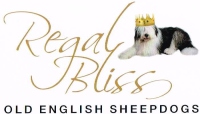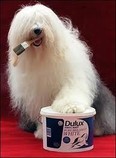History
The Old English Sheepdog is the brand mascot for Dulux paint. The dog was first introduced in Australian advertising campaigns in the 1960s. Since then they have been a constant and highly popular feature of Dulux television and print advertisements in both Australia and the UK, and people in those markets refer colloquially to the breed as a "Dulux dog".
Over the years, different dogs have appeared in the advertisements, all very similar in appearance, as most of them have been selected from a closely related line of pedigree dogs. The first Dulux dog was Shepton Dash, who held the role for eight years. His successor, Fernville Lord Digby, was the most famous Dulux dog and also made his owner, Cynthia Harrison, famous. When filming commercials, Digby was treated like a star and was driven to the studio by a chauffeur. Barbara Woodhouse was employed to train Digby and his three stunt doubles, who were used whenever specific tricks or actions needed to be filmed.
Apart from Dash, all the Dulux dogs have been breed champions. Five of them have won 'Best of Show' prizes. The most recent Dulux Dog, Don, is Crufts Qualified.
The Old English Sheepdog comes from the very old pastoral type dogs of England, but no records were kept of the dogs, and everything about the earliest types is guesswork. A small drop-eared dog seen in a 1771 painting by Gainsborough is believed by some to represent the early type of the Old English Sheepdog.[10] In the early 19th century a bobtailed drovers dog, called the Smithfield or Cotswold Cor, was noticed in the southwestern counties of England and may have been an ancestor. Most fanciers agree that the Bearded Collie was among the original stock used in developing today's breed.[11] Some speculate that the Russian Owtchar was among the breed's ancestors.[1]
The Old English Sheepdog was at first called the "Shepherd's Dog" and was exhibited for the first time at a show in Birmingham, England, in 1873. There were only three entries, and the judge felt the quality of the dogs was so poor that he offered only a second placing.[11] From that beginning, the breed became a popular show dog, and, although the shape of dog itself has changed very little over the years, elaborate grooming including backcombing and powdering the fur were recorded as early as 1907.[11] The breed was exported to the United States in the 1880s, and by the turn of the 20th century, five of the ten wealthiest American families bred and showed the Old English Sheepdog.[1] The breed continues to be a popular showdog today.


